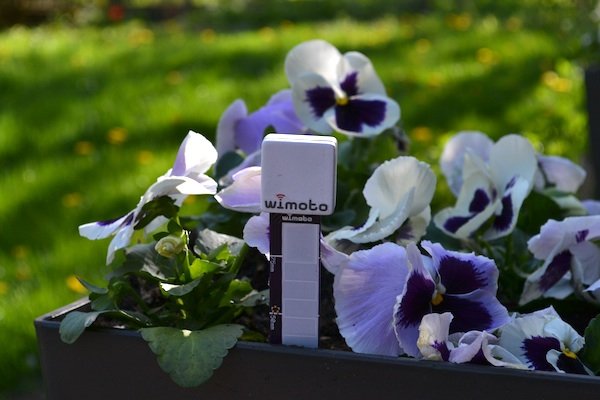Wimoto Motes are small (30x30x8mm) wireless sensors that communicate temperature, humidity, soil moisture… values to your iPhone, iPad, Android, and Linux (yes, including the Raspberry Pi) devices via Bluetooth. They are said to last for about a year on a single CR2032 battery and don’t require an Internet connection to work, but you can still upload your data to Wimoto cloud service via the app, or use an optional mote.cloud bridge to do it for you in realtime via Wifi.
There are currently 4 Motes:
- Climote – Measures light (0 to 60,000 lux), temperature (-25 to 85 C) and humidity. Used to monitor a room environment (bedroom, cellar, greenhouse,…), and tell you if you need to make adjustment
- Growmote – Measures sunlight (0 to 60,000 lux), soil moisture (5 levels) and temperature (-25 to 85 C), to make sure your lawn or flowers are not thirsty.
- Thermote – Measures an object temperature (-40 to 125 C) via infrared, so it does not need to touch the object.
- Securimote – Comes with an infrared motion sensor and an onboard accelerometer. Used for applications such as children monitoring, and house security.
Motes use Bluetooth SMART (aka Bluetooth Low Energy), which is part of Bluetooth 4.0, and under normal conditions and line of sight, you should be able to talk to your Motes within 30m. They also have internal storage which is big enough to store one week of data (with 15 minutes sampling rate), and can send an alert to your smartphone/tablet/computer once a threshold is reached. Motes can be used both indoor and outdoor, as they are water resistant, although they’re not waterproof, so they can’t be immersed.
There’s already an app for iOS devices (recent iPhone, iPad, and iPod touch), and an App for Android 4.3 devices with Bluetooth 4.0 support will be available in June or July. I understand there won’t be an app for Linux, but they’ll release details of their Bluetooth 4.0 profiles and services so that developers can access Motes from Linux, (or other operating systems) using BlueZ and some scripts.
The design is nearly complete, and Wimoto has launched an Indiegogo campaign in order to get funds for the plastic enclosure mold, regulatory testing, and mass-productions (at least 1,000 unit).
Each mote costs $39 + shipping ($10 in the US, and TBD in other locations), and you’ll need to pledge $99 in case you want the mote.cloud bridge to automatically send data to the Wimoto cloud service. They also offer bundle pledges where you can buy Motes for as low as $27.50 per unit. Climote, Growmote, and Thermote are expected to ship in August 2013, whereas Securimote should be available in October.

Jean-Luc started CNX Software in 2010 as a part-time endeavor, before quitting his job as a software engineering manager, and starting to write daily news, and reviews full time later in 2011.
Support CNX Software! Donate via cryptocurrencies, become a Patron on Patreon, or purchase goods on Amazon or Aliexpress





